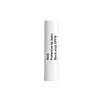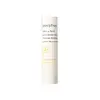What's inside
What's inside
 Key Ingredients
Key Ingredients

 Benefits
Benefits

 Concerns
Concerns

 Ingredients Side-by-side
Ingredients Side-by-side

Butyrospermum Parkii Butter
Skin ConditioningDiisostearyl Malate
EmollientPolyglyceryl-2 Triisostearate
EmulsifyingOctyldodecanol
EmollientMicrocrystalline Wax
Emulsion StabilisingEthylhexyl Methoxycinnamate
UV AbsorberRicinus Communis Seed Oil
MaskingCeresin
Emulsion StabilisingEthylhexyl Salicylate
UV AbsorberMeadowfoam Delta-Lactone
Skin ConditioningEuphorbia Cerifera Wax
Ozokerite
Emulsion StabilisingParaffin
PerfumingPolybutene
Jojoba Esters
EmollientOlea Europaea Fruit Oil
MaskingPolyethylene
AbrasiveSorbitan Sesquioleate
EmulsifyingPrunus Amygdalus Dulcis Oil
Skin ConditioningTribehenin
EmollientPolyglyceryl-6 Polyricinoleate
EmulsifyingRosa Damascena Flower Oil
MaskingOenothera Biennis Oil
EmollientCamellia Japonica Seed Oil
EmollientLimnanthes Alba Seed Oil
Skin ConditioningPrunus Armeniaca Kernel Oil
MaskingElaeis Guineensis Oil
EmollientCarthamus Tinctorius Seed Oil
MaskingHelianthus Annuus Seed Oil
EmollientTrihydroxystearin
Skin ConditioningTocopherol
AntioxidantDehydroacetic Acid
PreservativeParfum
MaskingButyrospermum Parkii Butter, Diisostearyl Malate, Polyglyceryl-2 Triisostearate, Octyldodecanol, Microcrystalline Wax, Ethylhexyl Methoxycinnamate, Ricinus Communis Seed Oil, Ceresin, Ethylhexyl Salicylate, Meadowfoam Delta-Lactone, Euphorbia Cerifera Wax, Ozokerite, Paraffin, Polybutene, Jojoba Esters, Olea Europaea Fruit Oil, Polyethylene, Sorbitan Sesquioleate, Prunus Amygdalus Dulcis Oil, Tribehenin, Polyglyceryl-6 Polyricinoleate, Rosa Damascena Flower Oil, Oenothera Biennis Oil, Camellia Japonica Seed Oil, Limnanthes Alba Seed Oil, Prunus Armeniaca Kernel Oil, Elaeis Guineensis Oil, Carthamus Tinctorius Seed Oil, Helianthus Annuus Seed Oil, Trihydroxystearin, Tocopherol, Dehydroacetic Acid, Parfum
Petrolatum
EmollientPolyglyceryl-2 Triisostearate
EmulsifyingDiisostearyl Malate
EmollientParaffinum Liquidum
EmollientJojoba Esters
EmollientHydrogenated Polyisobutene
EmollientPolyethylene
AbrasiveMeadowfoam Delta-Lactone
Skin ConditioningCholesteryl Hydroxystearate
EmollientHydrogenated Coco-Glycerides
EmollientEuphorbia Cerifera Wax
Microcrystalline Wax
Emulsion StabilisingMangifera Indica Seed Butter
Skin ConditioningCeresin
Emulsion StabilisingPrunus Amygdalus Dulcis Oil
Skin ConditioningTrihydroxystearin
Skin ConditioningPhenoxyethanol
PreservativeCaprylyl Glycol
EmollientTocopheryl Acetate
AntioxidantCamellia Japonica Seed Oil
EmollientSimmondsia Chinensis Seed Oil
EmollientGlyceryl Caprylate
EmollientParfum
MaskingTocopherol
AntioxidantTbhq
AntioxidantWater
Skin ConditioningCymbopogon Schoenanthus Oil
MaskingGlycerin
HumectantButylene Glycol
HumectantCamellia Sinensis Leaf Extract
AntimicrobialCitrus Unshiu Peel Extract
MaskingOpuntia Coccinellifera Fruit Extract
Skin ConditioningOrchid Extract
Skin ConditioningCamellia Japonica Leaf Extract
Skin ConditioningHoney Extract
HumectantEthylhexylglycerin
Skin ConditioningPetrolatum, Polyglyceryl-2 Triisostearate, Diisostearyl Malate, Paraffinum Liquidum, Jojoba Esters, Hydrogenated Polyisobutene, Polyethylene, Meadowfoam Delta-Lactone, Cholesteryl Hydroxystearate, Hydrogenated Coco-Glycerides, Euphorbia Cerifera Wax, Microcrystalline Wax, Mangifera Indica Seed Butter, Ceresin, Prunus Amygdalus Dulcis Oil, Trihydroxystearin, Phenoxyethanol, Caprylyl Glycol, Tocopheryl Acetate, Camellia Japonica Seed Oil, Simmondsia Chinensis Seed Oil, Glyceryl Caprylate, Parfum, Tocopherol, Tbhq, Water, Cymbopogon Schoenanthus Oil, Glycerin, Butylene Glycol, Camellia Sinensis Leaf Extract, Citrus Unshiu Peel Extract, Opuntia Coccinellifera Fruit Extract, Orchid Extract, Camellia Japonica Leaf Extract, Honey Extract, Ethylhexylglycerin
 Reviews
Reviews

Ingredients Explained
These ingredients are found in both products.
Ingredients higher up in an ingredient list are typically present in a larger amount.
Camellia Japonica Seed Oil comes from the Japanese Camellia plant. This plant is native to East Asia and known as "Tsubaki" in Japanese.
Camellia Japonica Seed Oil is rich in oleic acid. This makes it a great emollient. Emollients help soften and soothe the skin by forming a barrier. This barrier traps moisture within, keeping your skin hydated.
Ceresin is a wax derived from ozokerite. It is an alternative to beeswax.
The most common process of creating ceresin is by using heat and sulfuric acid.
Diisostearyl Malate is an emollient and most often used in lip products. It comes from isostearyl alcohol, a fatty acid, and malic acid, an AHA.
As an emollient, Diisostearyl Malate helps create a thin film on your skin to trap moisture in. This helps keep your skin soft and smooth.
Jojoba Esters is a wax created from Jojoba oil. It is an emollient and film-forming ingredient. In bead form, it is an exfoliator.
This ingredient has high oxidative stability, meaning it doesn't break down when exposed to oxygen.
Its similarity to our skin's natural oils makes it a great emollient. Emollients help soften and soothe our skin by creating a barrier on top. This barrier helps trap moisture in, keeping skin hydrated.
It is created using either the hydrogenation or transesterification processes on jojoba oil.
Learn more about Jojoba EstersWe don't have a description for Meadowfoam Delta-Lactone yet.
Microcrystalline Wax is created by de-oiling petroleum. It is highly refined and purified before being added to cosmetics.
Microcrystalline Wax is used to enhance the texture and create even consistency. It helps stabilize a product by preventing ingredients from separating.
Parfum is a catch-all term for an ingredient or more that is used to give a scent to products.
Also called "fragrance", this ingredient can be a blend of hundreds of chemicals or plant oils. This means every product with "fragrance" or "parfum" in the ingredients list is a different mixture.
For instance, Habanolide is a proprietary trade name for a specific aroma chemical. When used as a fragrance ingredient in cosmetics, most aroma chemicals fall under the broad labeling category of “FRAGRANCE” or “PARFUM” according to EU and US regulations.
The term 'parfum' or 'fragrance' is not regulated in many countries. In many cases, it is up to the brand to define this term.
For instance, many brands choose to label themselves as "fragrance-free" because they are not using synthetic fragrances. However, their products may still contain ingredients such as essential oils that are considered a fragrance by INCI standards.
One example is Calendula flower extract. Calendula is an essential oil that still imparts a scent or 'fragrance'.
Depending on the blend, the ingredients in the mixture can cause allergies and sensitivities on the skin. Some ingredients that are known EU allergens include linalool and citronellol.
Parfum can also be used to mask or cover an unpleasant scent.
The bottom line is: not all fragrances/parfum/ingredients are created equally. If you are worried about fragrances, we recommend taking a closer look at an ingredient. And of course, we always recommend speaking with a professional.
Learn more about ParfumPolyethylene is a synthetic ingredient that helps the skin retain moisture. It is a polymer.
It is also typically used within product formulations to help bind solid ingredients together and thicken oil-based ingredients. When added to balms and emulsions, it helps increase the melting point temperature.
This ingredient is a form of glycerin with emulsifying and emollient properties.
As an emulsifier, this ingredient helps keep products together while adding a thick texture. The manufacturer states this ingredient has emollient properties. Emollients help keep the skin hydrated by trapping moisture in.
Polyglyceryl-2 Triisostearate is created by reacting diglycerin and isostearic acid. Due to the isostearic acid base, it may not be safe for Malassezia or fungal acne.
Learn more about Polyglyceryl-2 TriisostearatePrunus Amygdalus Dulcis Oil comes from the sweet almond, a tree native to Iran. This oil has no fragrance and is non-volatile.
Almonds contain healthy fats, vitamins, and minerals. It is a rich source of Vitamin E, a great antioxidant and skin conditioning ingredient. Sweet almond oil contains fatty acids such as linolenic acid and triglycerides.
The content of sweet almond oil makes it a great emollient; it can help soften and hydrate your skin. Emollients create a barrier over your skin to trap moisture in. Sweet almond oil has antioxidant properties.
Those with an almond allergy should be careful of this ingredient and speak with a professional about using it in your skincare.
This ingredient may not be fungal-acne safe.
Learn more about Prunus Amygdalus Dulcis OilTocopherol (also known as Vitamin E) is a common antioxidant used to help protect the skin from free-radicals and strengthen the skin barrier. It's also fat soluble - this means our skin is great at absorbing it.
Vitamin E also helps keep your natural skin lipids healthy. Your lipid skin barrier naturally consists of lipids, ceramides, and fatty acids. Vitamin E offers extra protection for your skin’s lipid barrier, keeping your skin healthy and nourished.
Another benefit is a bit of UV protection. Vitamin E helps reduce the damage caused by UVB rays. (It should not replace your sunscreen). Combining it with Vitamin C can decrease sunburned cells and hyperpigmentation after UV exposure.
You might have noticed Vitamin E + C often paired together. This is because it is great at stabilizing Vitamin C. Using the two together helps increase the effectiveness of both ingredients.
There are often claims that Vitamin E can reduce/prevent scarring, but these claims haven't been confirmed by scientific research.
Learn more about TocopherolThis ingredient comes from Hydroxystearic Acid, a fatty acid, and glycerin. It is used to thicken oils.
Due to its fatty acid content, it is a natural emollient.
Creating trihydroxystearin involves using a chemical reaction between hydrogen and castor oil.
This ingredient may not be Malassezia folliculitis safe.
Learn more about TrihydroxystearinEuphorbia Cerifera wax comes from a shrub in Northern Mexico. It is used to stabilize formulations and has emollient properties.
Emollients form a thin layer on top of skin to prevent water from evaporating, keeping skin and lips hydrated.
According to a manufacturer, this wax can range from a yellow/brown color to translucent.
Learn more about Euphorbia Cerifera Wax